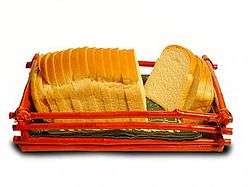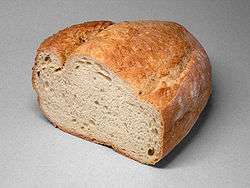Sliced bread
|
A loaf of white bread sliced to uniform thickness by a bread slicing machine | |
| Type | Bread |
|---|---|
|
| |
Sliced bread is a loaf of bread that has been sliced with a machine and packaged for convenience. It was first sold in 1928, advertised as "the greatest forward step in the baking industry since bread was wrapped".[1] This led to the popular phrase, "greatest thing since sliced bread".
History



Otto Frederick Rohwedder of Davenport, Iowa, United States, invented the first loaf-at-a-time bread-slicing machine. A prototype he built in 1912 was destroyed in a fire[2] and it was not until 1928 that Rohwedder had a fully working machine ready. The first commercial use of the machine was by the Chillicothe Baking Company of Chillicothe, Missouri, which produced their first slices on July 7, 1928.[3] Their product, "Kleen Maid Sliced Bread", proved a success. Battle Creek, Michigan, has a competing claim as the first city to sell bread sliced by Rohwedder's machine; however, historians have produced no documentation backing up Battle Creek's claim.[4] The bread was advertised as "the greatest forward step in the baking industry since bread was wrapped."
St. Louis baker Gustav Papendick bought Rohwedder's second bread slicer and set out to improve it by devising a way to keep the slices together at least long enough to allow the loaves to be wrapped.[2] After failures trying rubber bands and metal pins, he settled on placing the slices into a cardboard tray. The tray aligned the slices, allowing mechanized wrapping machines to function.[5]
W.E. Long, who promoted the Holsum Bread brand, used by various independent bakers around the country, pioneered and promoted the packaging of sliced bread beginning in 1928.[6] In 1930 Wonder Bread, first sold in 1925, started marketing sliced bread nationwide.
Effects
As commercially sliced bread resulted in uniform and somewhat thinner slices, people ate more slices of bread at a time, and ate bread more frequently, because of the ease of eating another piece of bread. This increased consumption of bread and, in turn, increased consumption of spreads, such as jam, to put on the bread.[2]
1943 U.S. ban on sliced bread
During 1943, U.S. officials imposed a short-lived ban on sliced bread as a wartime conservation measure.[7][8] The ban was ordered by Claude R. Wickard who held the position of Food Administrator, and took effect on January 18, 1943. According to the New York Times, officials explained that "the ready-sliced loaf must have a heavier wrapping than an unsliced one if it is not to dry out." It was also intended to counteract a rise in the price of bread, caused by the Office of Price Administration's authorization of a ten percent increase in flour prices.[9]
In a Sunday radio address on January 24, New York City Mayor LaGuardia suggested that bakeries that had their own bread-slicing machines should be allowed to continue to use them, and on January 26, 1943, a letter appeared in the New York Times from a distraught housewife:
- I should like to let you know how important sliced bread is to the morale and saneness of a household. My husband and four children are all in a rush during and after breakfast. Without ready-sliced bread I must do the slicing for toast—two pieces for each one—that's ten. For their lunches I must cut by hand at least twenty slices, for two sandwiches apiece. Afterward I make my own toast. Twenty-two slices of bread to be cut in a hurry![10]
On January 26, however, John F. Conaboy, the New York Area Supervisor of the Food Distribution Administration, warned bakeries, delicatessens, and other stores that were continuing to slice bread to stop, saying that "to protect the cooperating bakeries against the unfair competition of those who continue to slice their own bread... we are prepared to take stern measures if necessary."[11]
On March 8, 1943, the ban was rescinded. Wickard stated that "Our experience with the order, however, leads us to believe that the savings are not as much as we expected, and the War Production Board tells us that sufficient wax paper to wrap sliced bread for four months is in the hands of paper processor and the baking industry."[9]
Around the world
Due to its convenience, sliced bread is popular in many parts of the world, and the usual thickness varies by company and country:
- In the United Kingdom, sliced bread is sold as either "Extra Thick", "Thick", "Medium" or "Thin" varying across the 5-20mm range.
- In the Republic of Ireland, the most popular bread type is known as "sliced pan",[12] sold in 800- or 400-gram loaves, wrapped in wax paper, with the slices conveniently sized for making sandwiches and toast.
- In Japan, the same half-loaf of bread is labeled by the number of slices[13] (usually 4, 5, or 6, and occasionally 8 or 10). Thin sliced crustless "sandwich bread" is also sold in Japan, since regular 4-6 slice bread is deemed too thick.
- In Canada and the United States, Texas toast is a type of packaged bread which is sliced at double the typical thickness of most sliced breads.
In popular culture
The phrase "the greatest thing since sliced bread" is a common hyperbole used to praise an invention or development. A writer for The Kansas City Star wrote that "the phrase is the ultimate depiction of innovative achievement and American know-how."[1]
In 1940, a form of bread consisting of two wrapped half-loaves was advertised as the "greatest convenience since sliced bread".[14]
See also
- Pullman loaf, origin of a style of long narrow bread pan, and the loaves baked in it
- Sandwich bread
References
- 1 2 "History of sliced bread little known on 75th anniversary". The Kansas City Star. July 29, 2003. Archived from the original on August 12, 2003. Retrieved August 26, 2007.
- 1 2 3 Vorhees, Don (2004). Why do donuts have holes? : fascinating facts about what we eat and drink. New York: Citadel Press. pp. 112–113. ISBN 978-0-8065-2551-8. OCLC 56800212.
- ↑ "Sliced Bread Turns 80 Years Old". Chillicothe Constitution-Tribune. July 7, 2008. Retrieved July 6, 2011.
- ↑ Wenske, Paul. "History of sliced bread little known on 75th anniversary". Kansas City Star, July 28, 2003.
- ↑ Hammack, William. (2003). Commentary from Bill Hammack's Engineering and Life radio program. Text available from Engineerguy.com. Retrieved September 21, 2006.
- ↑ Holsum - History Archived January 10, 2007, at the Wayback Machine.
- ↑ Levenstein, Harvey (2003). Paradox of Plenty: A Social History of Eating in Modern America. University of California Press, p. 82.
- ↑ Burton, Bill. "Liberty: Best Thing Since Sliced Bread". Bay City Weekly, January 25, 2001. Archived October 13, 2006, at the Wayback Machine.
- 1 2 "Sliced Bread Put Back on Sale; Housewives' Thumbs Safe Again". The New York Times. March 6, 1943. p. 16. ban took effect Jan 18; explained as paper-saving due to ready-sliced loafs needing heavier wrapping; also explained as cost-cutting measure; unpopularity of measure; rescinded March 8; "four month's supply" of wax paper in the hands of bakers.
- ↑ Forrester, Sue (January 26, 1943). "Ready-Sliced Bread Favored". The New York Times. p. 8.
- ↑ "Bread-Slicing Ban Extended Further". The New York Times. January 26, 1943. p. 16.
- ↑ Monaghan, Gabrielle (October 4, 2009). "Scientists in Cork find a way to keep bread fresher". London: Times Online. Retrieved December 26, 2009.
- ↑ JET, Ishikawa (July 9, 2009). "Familiar Products at Japanese Supermarkets". ishikawajet.wordpress.com. Retrieved July 7, 2010.
- ↑ Advertisement for Southern Sliced Bread "Twin-Pack" The Bee (Danville, Virginia), 1940-02-23, p. 3
External links
| Wikimedia Commons has media related to Sliced bread. |
- US 1867377 — Rohwedder's 1928 bread slicer.
- "A Day in the Life" podcast on sliced bread.

